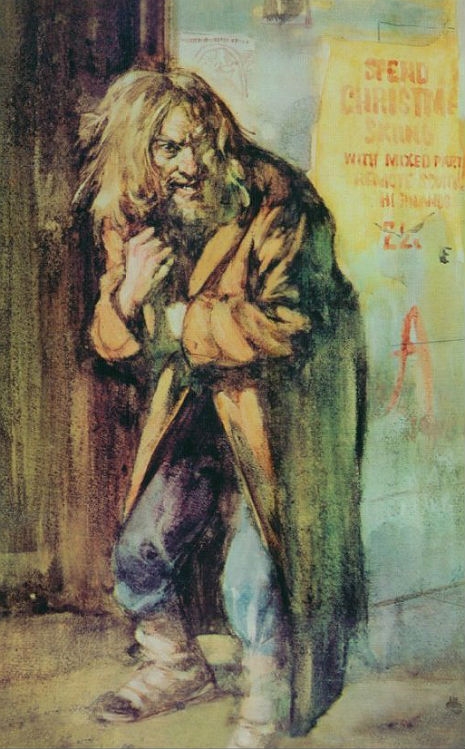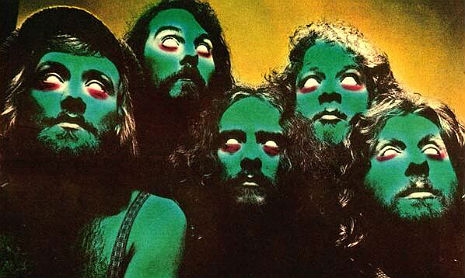
Burton Silverman’s iconic cover portrait of ‘Aqualung,’ the wheezing, shabby homeless man ‘eyeing little girls with bad intent’ who happens to look a lot like Ian Anderson
In 2016, Jethro Tull is one of those utterly amazing bands that is—sadly—very difficult to explain to those for whom they seem to hold no obvious appeal. Although once one of the very biggest concert draws in the world of music—and don’t get me wrong, they’re still a popular group—their fanbase is getting older each year and I don’t think it’s exactly getting any bigger with the passing of time. But for the sake of “the young people” who are reading this I’m going to try to get across why I think Jethro Tull are so great and why they deserve your attention. The occasion is Rhino’s re-release of their classic 1971 longplayer Aqualung, an album that I’m absolutely nuts about, on a 2 CD/2 DVD box set. I hope my enthusiasm will be contagious enough that you’ll give it a listen yourself.
I canvassed some of the other Dangerous Minds contributors about their opinions of Aqualung: Editor-at-large Marc Campbell relayed that he remembered “the scuzziest hippies smoking skunk weed and listening to that piece of crap.” Fair enough. He was there. Our Chris Bickel (who wasn’t) wondered “who the fuck is the audience for this jester-hat-wearing Renaissance Faire bullshit?” while acknowledging that its multi-platinum record status indicated there must have been quite a large one. My wife sees Jethro Tull as the sort of group that “old bikers listen to at keg parties in Cincinnati,” in the same category with say, Steppenwolf and Howie Pyro cited the time when I tried to force their Benefit album on him and how this resulted in “some kinda kneejerk anti-Tull punk reaction inside of me.”

All of these reactions are perfectly understandable. If you don’t really know what Jethro Tull are all about, being confronted with this scraggly-looking comically leering hirsute and freaky Dickensian hobo-sage character wearing thigh-high boots and a glittering codpiece playing the flute is simply confusing in 2016 isn’t it? Don’t worry I’m here to help you. Please try to keep an open mind, won’t you?
Until not all that long ago, I can’t really claim to have had much more than a passing familiarity with Jethro Tull’s music myself. Although one of the very first 45s that I ever bought was their “Bungle in the Jungle” in 1974, for the most part I just knew some of the greatest hits. A couple years back, a publicist at Rhino threw Steven Wilson’s 5.1 surround revisioning of their 1970 Benefit album in the package with something else that I’d asked for. I’ll listen to anything Steven Wilson has remixed for 5.1 and I was utterly floored by Benefit. I had never really thought all that much about Jethro Tull frankly, it was more about Wilson’s participation than anything else that had piqued my curiosity. Because I had no expectations one way or the other, Benefit hit me like a bolt from the blue. I was completely smitten with that album pretty much upon the first listen. My initial reaction was “Wow! How did a group this big never truly get on my radar before?” (Howie’s right: If you came of age during punk, Jethro Tull were simply a dinosaur band you avoided and that’s the straightforward answer).

Jethro Tull, stand up guys
I gorged myself on that album and fanned out through their back catalog. I liked their second effort Stand Up quite a bit and I also got way into their Living in the Past compilation. Their first album This Was I was less enthusiastic about—it’s just a basic blues thing, music they’d already outgrown before its release, hence the title—but the one that came after Benefit—that’s Aqualung—blew my doors off. If you consider yourself a fan of say, King Crimson, Captain Beefheart, Frank Zappa or even Nick Cave (who named one of his sons Jethro he was such a fan) you might have the same reaction I did: “HOW did I miss out on this?”
Obviously any discussion of Jethro Tull begins—and ends—with the group’s leader, the singular Ian Anderson, a rather brainy and idiosyncratic figure surely seen in retrospect (if not necessarily at the time) as the unlikeliest of arena rock gods. Anderson always read very “old” to me. At the time Aqualung was recorded he was just 23, but what a wizened old 23 he seemed to be. Some people are born old men, I guess, but by this age his lyrics were already becoming quite dark and deep. Aqualung‘s brooding, philosophically sophisticated subject matter included seeing homelessness people and doing nothing about it; how whatever kernel of truth there had been in Christianity had been co-opted by the Church of England and a cynical ruling class; and in “Locomotive Breath”—one of their signature numbers—humanity’s mad dash towards Hobbesian overpopulation.
Aqualung‘s liner notes included the following statement, an audacious sentiment to express in the early 1970s:
In the beginning Man created God;
And in the image of Man created he him.2 And Man gave unto God a multitude of names,
that he might be Lord over all the earth when it was suited to Man.3 And on the seven millionth day Man rested
and did lean heavily on his God and saw that it was good.4 And Man formed Aqualung of the dust of the ground,
and a host of others likened unto his kind.5 And these lesser men Man did cast into the void. And some were burned;
and some were put apart from their kind.6 And Man became the God that he had created
and with his miracles did rule over all the earth.7 But as these things did come to pass,
the Spirit that did cause Man to create his God
lived on within all men: even within Aqualung.8 And Man saw it not.
9 But for Christ’s sake he’d better start looking.

Here’s a stunning rendition of ‘My God’ (from ‘Aqualung’) performed in front of a crowd of 600,000 people at the 1970 Isle of Wight festival
Anderson’s decidedly bleak themes were backed by the majestic, intricately braided medieval tapestry of his acoustic guitar (Anderson’s thought of as the manic pirate flautist perched on one leg, of course, but his Bert Jansch-inspired guitar work is out-fucking-standing), his flute and the powerful dynamics of lead guitarist Martin Barre—one of rock’s single greatest riffmeisters barre none. The ensemble playing on Aqualung—which also included Clive Bunker on drums and percussion, the incredible John Evan on piano, organ, mellotron and “Jeffrey Hammond-Hammond” on bass guitar—is tight and agile, possessing an almost “classical” element, but not one that was bombastic like Emerson, Lake & Palmer or even necessarily orchestral for that matter. Jethro Tull had a “thing” which was unique to them.
Take for instance the gorgeous magical, swirling opening to “Cross Eyed Mary”:
When I first started listening to Aqualung, I’d play that particular song over and over and over again. Try “Hymn 43”:
The mighty and propulsive “Locomotive Breath” as used very effectively for a scene in ‘Fargo’
From Stand Up to Aqualung Jethro Tull were an absolutely incredible band. Admittedly after that my interest falls off sharply. Thick as a Brick, War Child, Passion Play—no thank you, the inspiration seems lacking, probably from exhaustion, the band toured almost constantly in the 1970s—but at this point in my life as one of the world’s most inveterate rock snobs I’d have to say that I easily consider Aqualung to be the equal of any Led Zeppelin album (and incidentally it was recorded in an adjacent studio to where Led Zeppelin were recording their own fourth album at Island Records’ newly opened facility in London.)
Rhino’s latest edition of Aqualung is a more economical release of Steven Wilson’s spectacular 2011 “40th anniversary” remix (both in sparkly stereo and a beyond amazing 5.1 surround version) more in line with the packaging and formatting of their other classic Jethro Tull sets of recent years. Aqualung was never considered to be a good-sounding “audiophile” album. It was recorded in a large, cold-sounding studio that had only recently been opened, and where the kinks (and the wiring) still needed to be worked out. The resulting mix was thin and murky, but apparently Wilson was able to coax magic from the multitracks (he compared his job to renovating the Sistine Chapel). When you listen to the stereo mix of “Cross Eyed Mary” posted above, imagine how crazy gorgeous that sounds coming at you from six speakers. So, so good.
Accept’s Mark Tornillo selected the ultimate Jethro Tull playlist. It’s a great place to start (I’d pick these same tracks myself). And here’s a round-up of some of the best early Jethro Tull videos I could find:
A (nearly) full set at Tanglewood Music Center in Lenox, Massachusetts on July 7th, 1970
Doing “Bouree” on French television
An incredible live performance of “With You There to Help Me” on German TV’s ‘Beat-Club’
“The Witches Promise” on ‘Beat-Club’
“A Song for Jeffrey” on French TV
The “Life is a Long Song” promo film
“Teacher” on Beat-Club’
“Living in the Past”